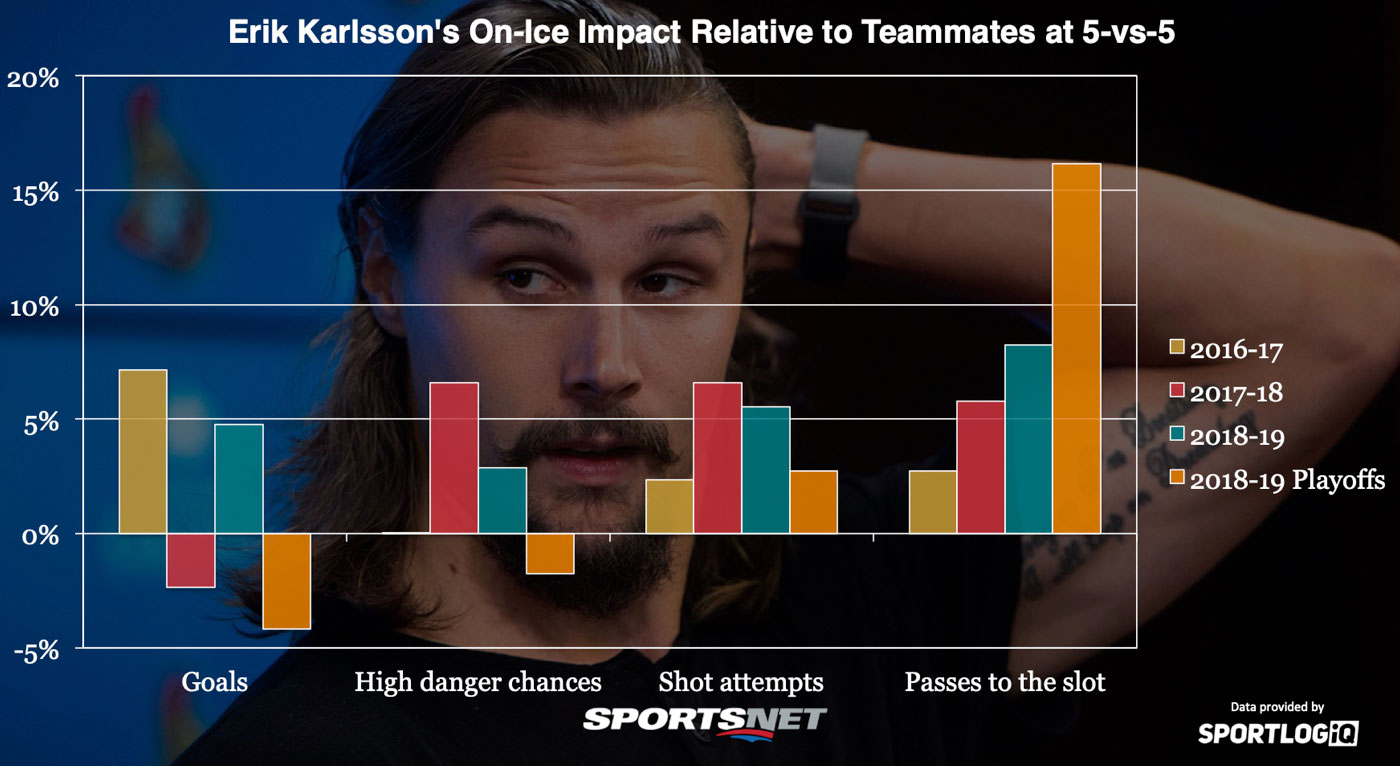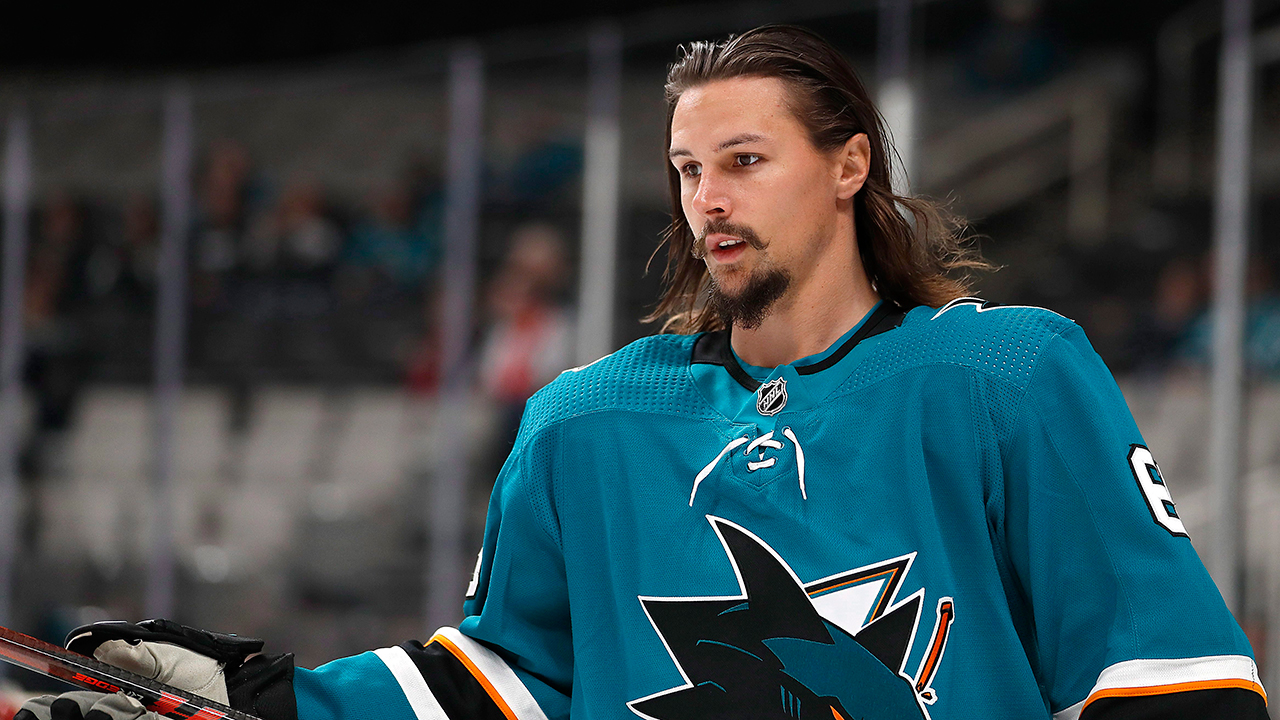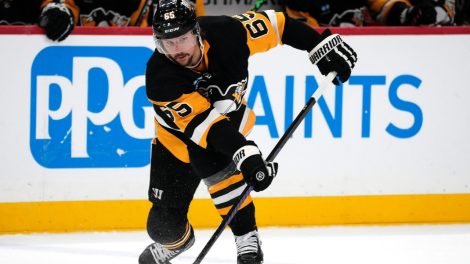Throughout the 2018-19 NHL season there has been a wide division on opinion about Erik Karlsson. Ever since he won his first Norris Trophy way back in 2011-12 — a controversial choice at the time — he has been considered among the league’s best defencemen.
Based on the numbers that I deal with on a daily basis, he has undisputedly been the best defenceman in the NHL since 2013-14 which, for the record, is after Matt Cooke accidentally sliced Karlsson’s Achilles tendon and caused him to miss nearly an entire season.
Since that time Karlsson has had lingering injury troubles despite not missing many games until this season, but he has always found a way to maintain his dominance at the top of the field in his position. Using the year-by-year breakdowns from my Sportsnet ranking project I do every summer, since 2013-14 Karlsson has ranked 1st, 2nd, 1st, 1st, and 2nd each season. He was beaten out once by P.K. Subban and once by Drew Doughty, but not varying nearly as much as either of them on a year-by-year basis.
When you’re playing at that high of a level with a relatively strong consensus about it, any drop in performance is going to be highlighted. There will undoubtedly be a large group of fans, observers, analysts, and media who are looking for a story about the best no longer being the best. Just ask Sidney Crosby how many times he metaphorically ‘passed the baton’ as the best player in the world before Connor McDavid arrived on the scene and actually earned that label.
This year, for the first time since the lockout-shortened 2013 season, Karlsson missed more than 11 games. He played in just 53 regular season matches and was besieged by the unluckiest start to a season of his career. Despite the fact the underlying numbers showed that Karlsson was his normal, dominant self in the first month of the season, his on-ice goal differential was terrible and his point production was not what everyone expected, so criticism began to mount.
[snippet ID=3322139]
Paired with the bad goal differential, people have been noticing for a couple of seasons now that Karlsson has had difficulty pivoting on his bad foot, which has exposed him off the rush and caused him to be at fault for goals against. This has led to the assumption that Karlsson might just be damaged goods now, which is a tough thing for a generational defenceman heading into unrestricted free agency.
But is it actually true?
The difficulty with pivoting absolutely exists and it may be something Karlsson has to deal with for the rest of his career, but how much of an effect that has on his on-ice impact is up for debate.
There are a couple issues of perception working against Karlsson at the moment. For example his on-ice save percentage at 5-on-5 was just .8947 in the regular season, which is a little outrageous even on a team that struggled to get saves. However, it was even worse last season at .8917 — both numbers are far off from the previous four seasons that fluctuated between .910 and .9262.
With that said, Karlsson has almost always had a negative impact on his team’s on-ice save percentage.

Part of that comes from facing top competition night in and out, and part is the pressure that was put upon him to create offence in Ottawa, which forced him to take more risks. But I don’t think we can rule out that Karlsson individually does things that leads to tougher situations for his goalies.
Throughout his career, Karlsson has had significantly more success driving on-ice shooting percentage than on-ice save percentage, but despite the lower save percentages he’s maintained some of the best overall defensive metrics in the game.
His low on-ice save percentage relative to teammates isn’t new this season — it’s a part of how Karlsson plays.
The other area of perception working against Karlsson comes from his own shooting percentage.
From his breakout second season up until 2016-17, Karlsson scored on 7.29 per cent of his shots on goal — a spectacular number for a defenceman. His shooting was consistent, too, never wavering beyond 6.5 to 7.8 per cent over a full season, until last year. In 2017-18 he scored on just 4.6 per cent of his shots and this season just 1.8 per cent.
[snippet id=3816507]
Two seasons do not make a trend, especially two beset by injuries, but it’s entirely within reason to worry if Karlsson’s goal scoring is evaporating. The thing is, his on-ice impact remains unaffected by it.
It’s worth pointing out that his poor goal differential from earlier in the season self-corrected as the year wore on and while Karlsson was on the ice the Sharks had a goal differential that was 4.75 per cent better than when he was on the bench.
The issue for Karlsson now is that his playoffs started much like his regular season did, and the Sharks are 4.16 per cent worse in goal differential with him on the ice than when he’s off in the playoffs.
My policy is never to put too much stock in short-term playoff performance, but nevertheless, let’s examine Karlsson’s play relative to his teammates recently and find out if there are any major warning signs.

Goals fluctuate a lot, but even going back to the 2016-17 season where we last saw “fully healthy” Karlsson, his numbers in San Jose this regular season compare remarkably strong.
In the playoffs Karlsson has seen his control of high danger chances drop into the red, but he’s still strong in shot attempt differential. It appears he has become extremely focused on controlling passes to the slot, where he has improved each of the past two seasons in relative impact and gone absolutely bonkers in the playoffs. [sidebar]
Pass defence is something defencemen can reliably control more often than high danger scoring chances, so I wouldn’t be too worried about how Karlsson’s looking here. In fact, despite the bad goal differential he appears to be having a pretty strong post-season.
There is of course, on more factor: the pivoting.
Karlsson’s mobility issues in that specific area aren’t enough to drag him out of elite player status by any stretch. It’s not like he’s suddenly a bad skater, but it is an area where opponents can exploit him.
The question then becomes how much of an exploitable weakness is it? When Karlsson gets caught it’s always going to show up in highlight reels, so our brains will bookmark those moments in our memories and prioritize them. But on balance, is Karlsson a liability off the rush because of his pivoting?
We can go back to 2016-17 and look at a three-year stretch to see how Karlsson handles chances off the rush compared to his teammates.

For the two previous seasons, Karlsson has been a mostly average defenceman at handling and creating chances off the rush, although you have to account for the increased level of difficulty that comes with playing against the best opponents most nights. That alone should dispel any worry that Karlsson is a particular liability off the rush, but this season should put that idea six feet under the ground.
Not only was Karlsson better than team average at controlling rush chances this season, he was absurdly effective, improving his teammates’ differentials by 6.5 per cent while he shared the ice with them.
Eventually Karlsson is going to decline. Time is undefeated in sports and in life.
But it hasn’t happened to him yet and whatever limitations have worked their way into Karlsson’s game over the years, he has found ways to compensate and remain dominant.
Anyone imagining that he would all of a sudden be a problem for whatever team he signs with this summer is going to be very wrong.
[relatedlinks]








